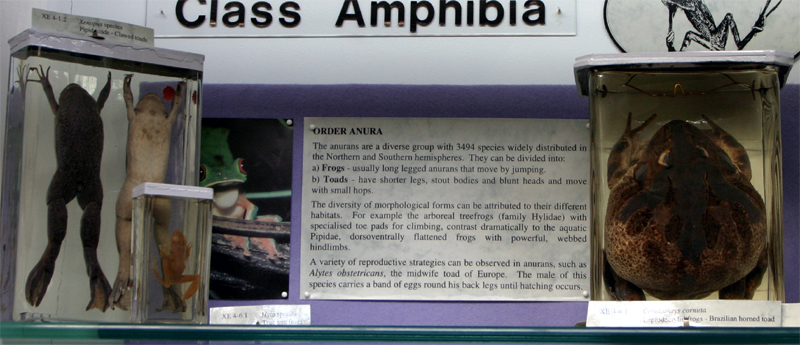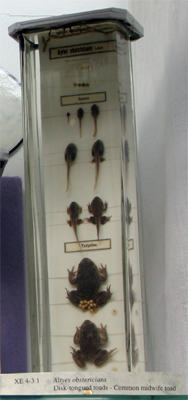
ORDER ANURA
Anurans, the frogs and toads, are a diverse group with about 3500 species widely distributed in the Northern and Southern hemispheres. Anurans can be distinguished from other amphibians because the adults lack a tail. The diversity of morphological forms among anurans can be attributed to different species living in different habitats.
Frogs are usually long-legged anurans that move by jumping. Toads have shorter legs, stout bodies and blunt heads and move with small hops. The two body types are not the result of diverging evolution. Species of smooth-skinned, long-limbed ‘frogs’ living in water may occur in the same families as species of ugly stout-bodied, warty-skinned ‘toads’ living in dark, damp places. Their large eyes indicate the importance of vision for catching prey.

From left to right: Xenopus species are clawed toads belonging to the aquatic family Pipidae. They are dorso-ventrally flattened toads with powerful, webbed hind limbs for swimming. Hyla species are slim, arboreal tree frogs, belonging to the family Hylidae. They have specialised toe-pads for climbing. Ceratorhys cornuta is the heavily built, Brazilian horned toad belonging to the family Leptodactylidae. Its horns are formed from hornlike flanges of skin projecting from the upper eye-lids.
REPRODUCTION
Anurans exhibit a variety of reproductive strategies ranging from laying eggs in water, building foam nests in vegetation, to laying eggs on land which develop directly into tiny froglets. Many species look after their young until they can fend for themselves. The aquatic development of the European frog, Rana esculenta, is seen here.

Right: Metamorphosis of the European midwife toad, Alytes obstetricans, shows how the male exhibits a simple form of parental care. The male carries the eggs in band around his back legs until the tadpoles hatch.






